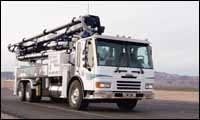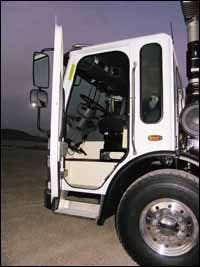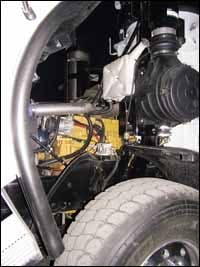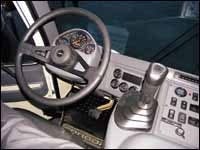Think of Class 8 low cab-over-engine trucks and you might name three or four: Mack's MR, Peterbilt's 320, the Xpeditor from Autocar (formerly Volvo and White), and Low Entry and Low Cab Forward models from Crane Carrier. But there's a fifth major name in the business: The Condor from Freightliner and its sister company, Sterling.
Freightliner is this country's largest single maker of over-the-road truck-tractors. It also fields a variety of vocational trucks but has found that trying to dominate the vocational markets, as it does OTR, is a different matter. Most customers have strong relationships with their dealers and see little reason to change if the trucks they're using are doing well.
So it is with the construction and trash-hauling businesses, for which the Condor and its competitors are built. Freightliner introduced the Condor in 1999, but it's still is a rarity in the field. Loyalty is great if you have it, but it's difficult to wrest away from strong rivals, no matter how capable your products might be.
My short outing in this Condor illustrated capabilities that more customers would appreciate if they tried it out. And as you can see from the lettering on this truck, one operator is doing just that. Protivin Builders, a three-truck concrete pumping operation in eastern Iowa, bought this vehicle through Star Equipment, the Schwing dealer in Cedar Rapids, Iowa.
Gary Pones, the small fleet's founder, owner and president, says he traded in an '88 White Xpeditor for the Freightliner. He decided to try the Freightliner because his drivers were unhappy with the idea of getting another Mack MR. His other two trucks are MRs, but he says they are cramped and rough riding.
"We love it," he said of the Condor. "It's got lots of room and a good ride." The Condor chassis cost $5,500 more than an MR, "but that is only one more payment for me. It's worth it."
Like many concrete-pumper chassis, this one was bought by the equipment manufacturer, in this case Schwing America in St. Paul, Minn., which installed the 39X body and set up the hydraulics system. The 39X has five hydraulic pumps, Pones explained, and they get pressurized fluid from the main pump that's driven by a front-engine power take-off.
A pumper body is bulky and heavy, which is why a compact but strong low COE is the chassis of choice. As it sits, this one is maxed out in length and weight. It's 40 feet long — the legal limit for a straight truck in most states — and weighs 60,000 pounds, the chassis' gross vehicle weight rating and the legally allowed amount for three axles in Iowa. So it's always "loaded" and never comes back empty, as mixer and dump trucks do.
Before Pones took delivery, Freightliner borrowed this rig from Schwing to show it off to potential customers and trade press writers during the World of Concrete show earlier this year in Las Vegas. For a no-frills work truck, the Condor proved rather comfortable on a designated street-and-freeway loop near the Freightliner dealership in North Las Vegas.
Let's start from the ground. Because the cab is mounted low on the frame, it's just a three-step climb to the inside floor. The cab's bumper-to-back-of-cab measurement is a compact 68 inches, but there is ample leg and belly room for all but the biggest guys. The cab is also wide at 96.5 inches (excluding steps and mirrors), so there's sufficient hip room and plenty of space for a driver's arms and elbows.
In this type of truck the driver sits next to the engine, which is covered by a high but well padded "doghouse." In other low COEs, the driver tends to hug the doghouse with his right leg, but the Condor's wide cab allows the driver to sit a little farther away. The doghouse is almost shoulder high, and this takes a little getting used to for anyone accustomed to driving a conventional-cab truck, where the engine's up front.
The driving position also takes some adjustment. For one thing, there's no single big instrument panel, but a series of small ones. A pod above the tilt-and-telescoping steering column contains a speedometer flanked by an air-pressure gauge and a tiny tachometer. Other engine-condition gauges are to the right and, an arm's reach away, on a central panel, which also has various rocker switches and a lever-switch to activate the PTO. Light switches are on the left, including some on the multi-function turn signal stalk.
The gearshift lever is in a sort of console that juts out of the dashboard, so you reach forward to manipulate it. It's easier than it looks, and I found that going through the Eaton Fuller 10-speed transmission was almost fun. The shift lever is connected by cables to the gear-change mechanism atop the tranny; the linkage worked smoothly, even though it was new-truck stiff.
Easy-to-drive Allison automatic transmissions go into about half of all Condors, Freightliner reps said, and into most of those built for toting trash-packer bodies.
The engine in this 2005-model truck is an '02 Caterpillar C-12, a diesel left over from the pre-October '02 emissions days. The C-12 is simpler and less costly than the Clean Power models that Cat sold for a while after the deadline and the ACERT products it now makes. Today's successor engine is the C13; Freightliner also offers the C7, C9 and C11, and the Cummins ISL in the Condor.
No Mercedes-Benz engines from Freightliner's parent, DaimlerChrysler, or Detroit Diesel, which Freightliner owns, have been engineered in. The Condor's low production volume has precluded that, but I'd be surprised if some of the new Detroit-Mercedes engines due out for 2007 don't appear in the Condor.
This Cat C-12's rating is 355 horsepower with 1,350 pounds-feet of torque, a modest output by today's standards, but entirely adequate to move the 60,000-pound truck even at freeway speeds. Cruising at 65 mph was easy in overdrive-10th gear. It was also comfortable, as long leaf springs over the rear-set steer axle flexed in a bus-like manner and the TufTrac leaf-and-rod suspension over the tandem rears was likewise compliant, especially under full load as this truck is.
There's also plenty of horses via the front PTO to operate the hydraulics on the Schwing pumper. Pones said the engine fast-idles at 1,100 to 1,200 rpm most of a work day to run the PTO, dropping fuel economy from a drive-only 6 mpg to about 4 mpg overall.
The body's 39-meter boom stayed stowed during this demo, as did its four stout outriggers. But we had to be careful not to hang up the rear set's pads on high ground. Another driver-reporter did that while coming down a shallow mound after leaving the pavement, but he was able to yank them free with a dose of power to the wheels, proving that brute force has its proper place.
Even with the big "duplex" tires on the front axle, wheel cut was tight and the truck was easy to turn into acute-angle corners. The steering wheel was curiously small in diameter for such a hefty truck, but that adds to belly room. And with power steering there was no effort required, and all I usually had to do was downshift to 6th gear and resume acceleration.
Freightliner says that the Condor's huge windshield, squarish rear window, two tall side windows, and rear-quarter panes together comprise more than 47 square feet of glass. They all add up to great outward visibility. Of course, there's no hood to see over and the low-mounted cab limits blind areas to those immediately to the truck's right. Well-placed twin-glass mirrors did a good job of helping me see there, and peer to the rear.
Refuse is the primary market for the Condor and other builders' low COEs, and most of their sales literature reflects this. But the Condor also makes a great concrete pumper chassis, according to Gary Pones, who's run this truck since April. "Everybody loves driving it," he said. "Now they don't want to drive the other trucks. That's the problem I have now."








